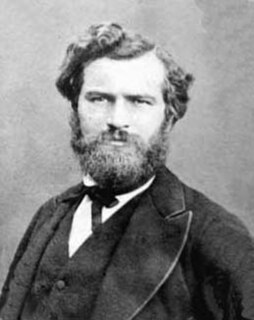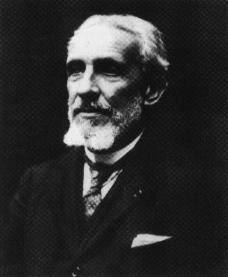
Holmium is a chemical element with the symbol Ho and atomic number 67. It is a rare-earth element and the eleventh member of the lanthanide series. It is a relatively soft, silvery, fairly corrosion-resistant and malleable metal. Like a lot of other lanthanides, holmium is too reactive to be found in native form, as pure holmium slowly forms a yellowish oxide coating when exposed to air. When isolated, holmium is relatively stable in dry air at room temperature. However, it reacts with water and corrodes readily, and also burns in air when heated.

Marie Ennemond Camille Jordan was a French mathematician, known both for his foundational work in group theory and for his influential Cours d'analyse.
The year 1878 in science and technology involved many significant events, listed below.

Alphonse Milne-Edwards was a French mammalogist, ornithologist, and carcinologist. He was English in origin, the son of Henri Milne-Edwards and grandson of Bryan Edwards, a Jamaican planter who settled at Bruges.

Ferdinand Jules Quénisset (1872–1951) was a French astronomer who specialized in astrophotography.

Édouard-Alfred Martel, the 'father of modern speleology', was a world pioneer of cave exploration, study, and documentation. Martel explored thousands of caves in his native France and many other countries, popularised the pursuit of cave exploration, introduced the concept of speleology as a distinct area of scientific study, maintained an extensive archive, and in 1895 founded Société de Spéléologie, the first organisation devoted to cave science in the world.

Holmium(III) oxide, or holmium oxide is a chemical compound of a rare-earth element holmium and oxygen with the formula Ho2O3. Together with dysprosium(III) oxide (Dy2O3), holmium oxide is one of the most powerfully paramagnetic substances known. The oxide, also called holmia, occurs as a component of the related erbium oxide mineral called erbia. Typically, the oxides of the trivalent lanthanides coexist in nature, and separation of these components requires specialized methods. Holmium oxide is used in making specialty colored glasses. Glass containing holmium oxide and holmium oxide solutions have a series of sharp optical absorption peaks in the visible spectral range. They are therefore traditionally used as a convenient calibration standard for optical spectrophotometers.
In spectroscopy, a Soret peak or Soret band is an intense peak in the blue wavelength region of the visible spectrum. The peak is named after its discoverer, Jacques-Louis Soret. The term is commonly used in absorption spectroscopy, corresponding to a wavelength of maximum absorption ranging around 400 nm in the blue region.
Comptes rendus de l'Académie des Sciences, or simply Comptes rendus, is a French scientific journal which has been published since 1835. It is the proceedings of the French Academy of Sciences. It is currently split into seven sections, published on behalf of the Academy by Elsevier: Mathématique, Mécanique, Physique, Géoscience, Palévol, Chimie, and Biologies.

Alexandre-Émile Béguyer de Chancourtois was a French geologist and mineralogist who was the first to arrange the chemical elements in order of atomic weights, doing so in 1862. De Chancourtois only published his paper, but did not publish his actual graph with the irregular arrangement. Although his publication was significant, it was ignored by chemists as it was written in terms of geology. It was Dmitri Mendeleev's table published in 1869 that became most recognized. De Chancourtois was also a professor of mine surveying, and later geology at the École Nationale Supérieure des Mines de Paris. He also was the Inspector of Mines in Paris, and was widely responsible for implementing many mine safety regulations and laws during the time.
The Proceedings of the USSR Academy of Sciences was a Soviet journal that was dedicated to publishing original, academic research papers in physics, mathematics, chemistry, geology, and biology. It was first published in 1933 and ended in 1992 with volume 322, issue 3.

The Lalande Prize was an award for scientific advances in astronomy, given from 1802 until 1970 by the French Academy of Sciences.

Charles-Emmanuel Sédillot was a French military physician and surgeon. He was the son of orientalist Jean Jacques Emmanuel Sédillot (1777–1832), and an older brother to historian Louis-Pierre-Eugène Sédillot.

The Valz Prize(Prix Valz) was awarded by the French Academy of Sciences, from 1877 through 1970, to honor advances in astronomy.

Louis de Mas Latrie was a 19th-century French historian.

Jean Lecomte was a French physicist, researcher and professor of physics at CNRS.

Wang Dezhao or Ouang Te-Tchao was a Chinese physicist who was known for his research in atmospheric electricity and underwater acoustics. Under the direction of Paul Langevin, he helped the French improve sonar at the beginning of World War II and after his return to China, Wang was considered as the founder of national defense water acoustics in China.

Count Antoine Alfred Arnaud Xavier Louis de Gramont was a French aristocrat with an interest in minerals, geology, and was a pioneer of spectroscopy. He conducted studies on pyroelectricity and dissociation spectroscopy in which he used an electric spark going through a mineral sample as a source to examine the spectra of the sample.
The Prix Bordin is a series of prizes awarded annually by each of the five institutions making up the Institut Français since 1835.
Frédéric Alphonse Musculus, born on July 16, 1829, in Soultz-sous-Forêts and died on May 26, 1888, in Strasbourg, was a French chemist.














